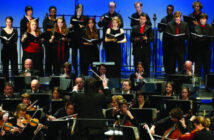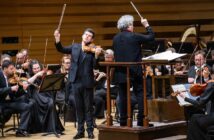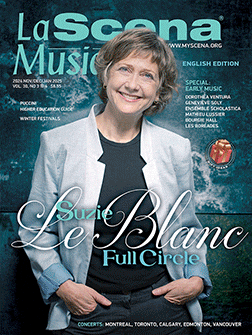
This page is also available in / Cette page est également disponible en:
![]() Francais (French)
Francais (French)
Inaugurated in the 1960s by the congregation of the Sisters of the Holy Name of Jesus and of Mary, the Claude-Champagne Hall is one of Montreal’s most iconic concert venues. Some of the largest music ensembles of the city have performed in this hall, marking several generations of music. Radio-Canada also occupied the premises until the mid-1970s and in those years they recorded its Grand Concerts. Today affiliated with the University of Montreal, the Claude-Champagne Hall continues to host many classical orchestras attracted by the authenticity and acoustic quality of the venue. The hall has also become the main venue for the Université de Montréal Orchestra, as well as offering residency to various musical ensembles.
Maintenance and aesthetic additions
Faced with aging installations, the administration of the Salle Claude-Champagne began in 2010 a huge project to restore certain elements of the structure and update the audiovisual equipment. The Montreal architecture firm CGA was entrusted with the task of giving back its acclaim to a concert hall that hosts more than 150 musical events per year.
Among the priorities, the replacement of the stage floor and seats, the addition of harrows and the repair of the piano elevator formed part of the first phase of the restoration operations. Out of service for years, the elevator can now contain two pianos, facilitating the logistics of concerts. For Pierre Corriveau, head of renovation work, the Claude-Champagne Hall has acquired in the course of it’s history a heritage value that is essential to preserve: “Even if it’s construction is fairly recent, in my opinion it is part of our cultural heritage. Apart from some previous repairs, the architectural features of the insides have remained more or less intact over the years. Given the scope and nature of the work, the risks of altering the sound signature of the room were great. To overcome this obstacle and preserve the original character of the room, the CGA team works in collaboration with acoustician Jean-Pierre Legault to choose materials that do not compromise the natural resonance.
Three years later, a second phase of restoration began with the replacement of the wooden panels located under the organ and on both sides of the stage. Heavily damaged over the years, these panels not only play a key role in the distribution of sound, but are also a central component of the visual identity: occupying the entire back of the room, these wood panels are very visible from the point of the viewers. Once again, it was essential for the architects to remain faithful to the original aesthetics of the room.
Improvement of technical resources
While maintenance is an important part of the hall restoration project, a section dedicated to improving technical resources and upgrading stage equipment is also underway. As Corriveau points out, the arrival of new lighting and sound technologies offers new possibilities for artists. Depending on their vocation, concert halls are generally required to meet the technical requirements of the productions, otherwise they fall into disuse. With this in mind, CGA’s team of architects collaborates with the technicians of Salle Claude-Champagne to assess new technical requirements: new harrows are added in 2010 and 2016, offering the technical team new possibilities as well as greater flexibility. A retractable cinema screen was also installed, offering the possibility of hosting interdisciplinary artistic productions.
However, it is important for Corriveau to respect the primary purpose of the facilities and “to integrate new technologies without altering the glamour.” The Claude-Champagne Hall was designed primarily as a venue for musical performances. It is therefore up to the architect to strike a balance between the preservation of the stamp and the technical needs, to create a space that meets the expectations of different parties.
Laboratory of research and creation
The third phase of the works began in 2016 and culminated with the inauguration of a research and creation laboratory in the Claude-Champagne Hall. Led by the Center for Interdisciplinary Research in Music, Media and Technology (CRIMMT), this ambitious project consists in providing the room with acoustic parameters control devices, in addition to offering tools for data collection. A control room is also set up at the back, allowing researchers to analyze the musical performances in real time. The project also sees Claude-Champagne be paired with the multimedia room of McGill’s Schulich School of Music in order to set up a sound experimental infrastructure. For example, researchers can connect the two rooms directly during experiments in order to simultaneously study two groups of listeners exposed to the same music.
Future prospects
If much remains to be done before the Claude-Champagne room is completely refurbished, the work will have to wait, for lack of financial means. In any case, it is illusory according to Corriveau to think that we can bring a room back to its original state: with the change of technologies and the needs of artists, it is necessary for a concert hall to evolve in order to continue to renew the experience of spectators and artists, while respecting its heritage value.
www.musique.umontreal.ca
Translated by Adrian Rodriguez.
This page is also available in / Cette page est également disponible en:
![]() Francais (French)
Francais (French)














